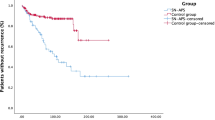Abstract
We performed a cross-sectional study of all antiphospholipid syndrome (APS) patients during an 8-year period (2006–2013) to describe the clinical features, serology profiles, treatment regimes, and outcomes in our center. There were a total of 59 patients in our study with the female to male ratio of 9:1. They have a mean age of 41.6 ± 12.1 years and a mean duration of illness of 38.4 ± 68.5 months. The majority of patients presented with vascular thrombosis (69.5 %) with equal arterial and venous involvements. Twenty-six patients (44.1 %) presented with obstetric complications with recurrent abortions (32.2 %) as the main manifestation. Most patients were on daily warfarin doses of 2–6 mg (91.0 %) with target INR of 2–3. There was neither recurrent thrombosis nor bleeding complications documented. There were 80 % live births following treatment in our patients.
Similar content being viewed by others
References
Comarmond C, Cacoub P (2013) Antiphospholipid syndrome: from pathogenesis to novel immunomodulatory therapies. Autoimmun Rev 12:752–757
Cervera R, Rodriguez-pinto I, Colafrancesco S, et al. (2014) 14th International Congress on Antiphospholipid Antibodies Task Force Report on Catastrophic Antiphospholipid Syndrome. Autoimmun Rev
de Jesus GR, Agmon-Levin N, Andrade CA, et al. (2014) 14th International Congress on Antiphospholipid Antibodies Task Force Report on Obstetric Antiphospholipid Syndrome. Autoimmun Rev
Erkan D, Aguiar CL, Andrade D, et al. (2014) 14th International Congress on Antiphospholipid Antibodies Task Force Report on Antiphospholipid; Syndrome Treatment Trends. Autoimmun Rev; Mar. 20
Cervera R, Piette JC, Font J et al (2002) Antiphospholipidsyndrome:clinical and immunologic manifestations and patterns of diseaseexpression in a cohort of 1,000 patients. Arthritis Rheum 46:1019–1027
Cervera R, Serrano R, Pons-Estel GJ, et al. (2014 Jan 24) Morbidity and mortality in the antiphospholipid syndrome during a 10-year period: a multicentre prospective study of 1000 patients. Ann Rheum Dis
Yoon KH, Fong KY, Sivalingam P et al (2003) Antiphospholipidsyndromein Asians: clinical manifestations, serological markers and outcomeof the National University of Singapore/National UniversityHospitalantiphospholipid cohort. APLAR J Rheumatol 6:128–136
Tan BE, Thong BY, Shivananda S, Han WW, Chng HH (2009) Clinical manifestations and outcomes of antithrombotic treatment of the Tan Tock Seng Hospital Singapore antiphospholipid syndrome cohort. Lupus 18:752–758
Mok CC, Chan PT, Ho LY, Yu KL, To CH (2013) Prevalence of the antiphospholipid syndrome and its effect on survival in 679 chinese patients with systemic lupus erythematosus: a cohort study. Medicine (Baltimore) 92:217–222
Basiri Z, Gholyaf M, Faridnia M, Nadi E, Bairanvand M (2013) The prevalence of anticardiolipin antibody in patients with systemic lupus erythematosus and its association with clinical manifestations. Acta Med Iran 51:35–40
Fujieda Y, Atsumi T, Amengual O et al (2012) Predominant prevalence of arterial thrombosis in Japanese patients withantiphospholipid syndrome. Lupus 21:1506–1514
Malaviya AN, Marouf R, Al-Jarallah K et al (1996) Hughes syndrome: a common problem in Kuwait Hospitals. Br J Rheumatol 35:1132–1136
Miyakis S, Lockshin MD, Atsumi T et al (2006) International consensus statement on anupdate of the classification criteria for definite antiphospholipid syndrome (APS). J Thromb Haemost 4:295–306
Hughes GR, Khamashta MA (2003) Seronegative antiphospholipid syndrome. Ann Rheum Dis 62:1127
Rodriguez-Garcia JL, Bertolaccini ML, Cuadrado MJ, Sanna G, Ateka-Barrutia O, Khamashta MA (2012) Clinical manifestations of antiphospholipid syndrome (APS) with and without antiphospholipid antibodies (the so-called ‘seronegative APS’). Ann Rheum Dis 71:242–244
Crowther MA, Ginsberg JS, Julian J et al (2003) A comparison of twointensities of warfarin for the prevention of recurrent thrombosis inpatients with the antiphospholipid antibody syndrome. N Engl J Med 349:1133–1138
Finazzi G, Marchioli R, Brancaccio V et al (2005) A randomized clinical trial of high-intensity warfarin vs. conventional antithrombotic therapy for the prevention of recurrent thrombosis in patients with the antiphospholipid syndrome (WAPS). J Thromb Haemost 3:848–853
Stern C, Chamley L, Norris H et al (2003) A randomized double-blind, placebo-controlled trial of heparin and aspirin for women with in vitro fertilization implantation failure and antiphopspholipid or antinuclear antibodies. Fertil Steril 80:3376–3383
Alijotas-Reig J, Ferrer-Oliveras R, EUROAPS Study Group (2012) The European Registry on Obstetric Antiphospholipid Syndrome (EUROAPS): a preliminary first year report. Lupus 21:766–768
Acknowledgments
We would like to acknowledge the support of the Ministry of Health, Malaysia for technical support of the study. We would also like to thank Mr Ghoon Hoong Cheh, final year medical student from King’s College London School of Medicine for his contribution for this study.
Disclosures
None
Author information
Authors and Affiliations
Corresponding author
Rights and permissions
About this article
Cite this article
Teh, C.L., Leong, T.S. Antiphospholipid syndrome in Sarawak: real world experience in a developing country. Clin Rheumatol 34, 175–178 (2015). https://doi.org/10.1007/s10067-014-2671-6
Received:
Revised:
Accepted:
Published:
Issue Date:
DOI: https://doi.org/10.1007/s10067-014-2671-6




